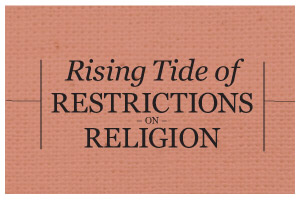

The Pew Research Center’s Forum on Religion & Public Life has on September 20, 2012 released the third in a series of reports analyzing the extent to which governments and societies around the world impinge on religious beliefs and practices. The new report looks at the extent and direction of change in religious restrictions from the year ending in mid-2009 to the year ending in mid-2010. Where appropriate, it also compares the situation as of mid-2010 with the situation in the baseline year of the study (mid-2006 to mid-2007). According to the report, a "rising tide of restrictions on religion" spread across the world during this perioid. Restrictions on religion rose in each of the five major regions of the world – including in the Americas and sub-Saharan Africa, the two regions where overall restrictions previously had been declining.
The share of countries with high or very high restrictions on religious beliefs and practices rose from 31% in the year ending in mid-2009 to 37% in the year ending in mid-2010. Because some of the most restrictive countries are very populous, three-quarters of the world’s approximately 7 billion people live in countries with high government restrictions on religion or high social hostilities involving religion, up from 70% a year earlier.
Restrictions on religion rose not only in countries that began the year with high or very high restrictions or hostilities, such as Indonesia and Nigeria, but also in many countries that began with low or moderate restrictions or hostilities, such as Switzerland and the United States.
These reports have drawn widespread attention to the fact that a substantial portion of the world’s population – 75% as of mid-2010 – lives in countries where governments, social groups or individuals restrict people’s ability to freely practice their faith. The reports also have generated significant interest for how they bring social science research methods to bear on the study of religious restrictions. The methodology used in the reports provides a quantitative framework that those involved in the study of religious freedom can use to monitor changes in restrictions on religion over time, across the world, in specific geographical regions and in individual countries.
(Text above taken from the Report)
To view the full report, as well as the reports issued in 2011 and 2009, click the links below.
